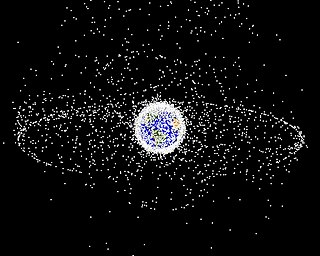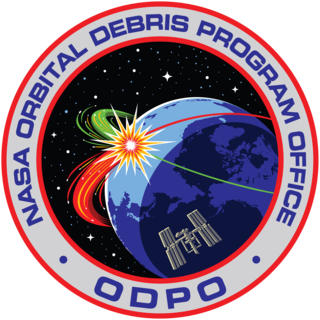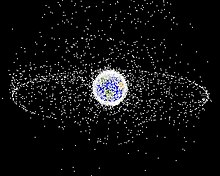
Space debris are defunct human-made objects in space – principally in Earth orbit – which no longer serve a useful function. These include derelict spacecraft, mission-related debris, and particularly-numerous in-Earth orbit, fragmentation debris from the breakup of derelict rocket bodies and spacecraft. In addition to derelict human-made objects left in orbit, space debris includes fragments from disintegration, erosion, or collisions; solidified liquids expelled from spacecraft; unburned particles from solid rocket motors; and even paint flecks. Space debris represents a risk to spacecraft.

The Discovery Program is a series of Solar System exploration missions funded by the U.S. National Aeronautics and Space Administration (NASA) through its Planetary Missions Program Office. The cost of each mission is capped at a lower level than missions from NASA's New Frontiers or Flagship Programs. As a result, Discovery missions tend to be more focused on a specific scientific goal rather than serving a general purpose.

A laser broom is a proposed ground-based laser beam-powered propulsion system that sweeps space debris out of the path of artificial satellites to prevent collateral damage to space equipment. It heats up one side of the debris to shift its orbit trajectory, altering the path to hit the atmosphere sooner. Space researchers have proposed that a laser broom may help mitigate Kessler syndrome, a runaway cascade of collision events between orbiting objects. Additionally, laser broom systems mounted on satellites or space station have also been proposed.

The Kessler syndrome, proposed by NASA scientist Donald J. Kessler in 1978, is a scenario in which the density of objects in low Earth orbit (LEO) due to space pollution is numerous enough that collisions between objects could cause a cascade in which each collision generates space debris that increases the likelihood of further collisions. In 2009, Kessler wrote that modeling results had concluded that the debris environment was already unstable, "such that any attempt to achieve a growth-free small debris environment by eliminating sources of past debris will likely fail because fragments from future collisions will be generated faster than atmospheric drag will remove them". One implication is that the distribution of debris in orbit could render space activities and the use of satellites in specific orbital ranges difficult for many generations.

The NASA Orbital Debris Program Office is located at the Johnson Space Center and is the lead NASA center for orbital debris research. It is recognized world-wide for its leadership in addressing orbital debris issues. The NASA Orbital Debris Program Office has taken the international lead in conducting measurements of the environment and in developing the technical consensus for adopting mitigation measures to protect users of the orbital environment. Work at the center continues with developing an improved understanding of the orbital debris environment and measures that can be taken to control its growth.

Project West Ford was a test carried out by Massachusetts Institute of Technology's Lincoln Laboratory on behalf of the United States military in 1961 and 1963 to create an artificial ionosphere above the Earth. This was done to solve a major weakness that had been identified in military communications.

Space-based solar power is the concept of collecting solar power in outer space with solar power satellites (SPS) and distributing it to Earth. Its advantages include a higher collection of energy due to the lack of reflection and absorption by the atmosphere, the possibility of very little night, and a better ability to orient to face the Sun. Space-based solar power systems convert sunlight to some other form of energy which can be transmitted through the atmosphere to receivers on the Earth's surface.

The National Aeronautics and Space Administration is an independent agency of the U.S. federal government responsible for the civil space program, aeronautics research, and space research. Established in 1958, it succeeded the National Advisory Committee for Aeronautics (NACA) to give the U.S. space development effort a distinct civilian orientation, emphasizing peaceful applications in space science. It has since led most of America's space exploration programs, including Project Mercury, Project Gemini, the 1968–1972 Apollo Moon landing missions, the Skylab space station, and the Space Shuttle. Currently, NASA supports the International Space Station (ISS) along with the Commercial Crew Program, and oversees the development of the Orion spacecraft and the Space Launch System for the lunar Artemis program.

DIRECT was a late-2000s proposed alternative super heavy lift launch vehicle architecture supporting NASA's Vision for Space Exploration that would replace the space agency's planned Ares I and Ares V rockets with a family of Shuttle-Derived Launch Vehicles named "Jupiter". It was intended to be the alternative to the Ares I and Ares V rockets which were under development for the Constellation program, intended to develop the Orion spacecraft for use in Earth orbit, the Moon, and Mars.
Donald J. Kessler is an American astrophysicist and former NASA scientist known for his studies regarding space debris.
The 100 Year Starship project (100YSS) was a one-year joint U.S. Defense Advanced Research Projects Agency (DARPA) and National Aeronautics and Space Administration (NASA) effort "to take the first step in the next era of space exploration—a journey between the stars". The study explored development of a viable and sustainable model for persistent, long-term, private-sector investment into the myriad of disciplines needed to make interstellar space travel practicable and feasible. The goal was to examine what it would take — organizationally, technically, sociologically and ethically — to develop the ability to send humans to another star within 100 years. The study culminated in a $500,000 grant awarded to a consortium under the lead of the Dorothy Jemison Foundation for Excellence, which led to the creation of an independent organization inheriting the name 100 Year Starship from DARPA. Annual 100YSS symposia were organized from 2011 to 2015, and again in 2023.
Space Infrastructure Servicing (SIS) is a spacecraft concept being developed by Canadian aerospace firm MDA to operate as a small-scale in-space refueling depot for communication satellites in geosynchronous orbit.

A number of space tethers have been deployed in space missions. Tether satellites can be used for various purposes including research into tether propulsion, tidal stabilisation and orbital plasma dynamics.
SpaceWorks Enterprises, Inc. (SEI) is an aerospace engineering company based in Atlanta, Georgia, United States that specializes in the design, assessment, hardware prototyping and flight demonstration of advanced space concepts for both government and commercial customers.

Busek Company Incorporated is an American spacecraft propulsion company that builds thrusters, electronics, and various systems for spacecraft.
The DARPA XS-1 was an experimental spaceplane/booster with the planned capability to deliver small satellites into orbit for the U.S. Military. It was reported to be designed to be reusable as frequently as once a day, with a stated goal of doing so for 10 days straight. The XS-1 was intended to directly replace the first stage of a multistage rocket by taking off vertically and flying to hypersonic speed and high suborbital altitude, enabling one or more expendable upper stages to separate and deploy a payload into low Earth orbit. The XS-1 would then return to Earth, where it could ostensibly be serviced fast enough to repeat the process at least once every 24 hours.
e.Deorbit was a planned European Space Agency active space debris removal mission developed as a part of their Clean Space initiative. The launch was planned for 2025 on board a Vega launch vehicle. Funding of the mission was stopped in 2018 in favor of the ClearSpace-1 mission, which is now under development.
Next Space Technologies for Exploration Partnerships (NextSTEP) is a NASA program using a public-private partnership model that seeks commercial development of deep space exploration capabilities to support more extensive human space flight missions in the Proving Ground around and beyond cislunar space—the space near Earth that extends just beyond the Moon.

The International-Mars Ice Mapper (I-MIM) mission is a proposed Mars orbiter being developed by NASA in collaboration with the Japan Aerospace Exploration Agency (JAXA), the Canadian Space Agency (CSA), and the Italian Space Agency (ASI). As the mission concept evolves, there may be opportunities for other space agency and commercial partners to join the mission. The goal of the orbiter is the quantification of extent and volume of water ice in non-polar regions of Mars. The results are intended to support future Mars missions, especially with respect to the search for habitable environments and accessible In situ resource utilization (ISRU) resources. The International-Mars Ice Mapper is an "exploration precursor mission", comparing it to the Lunar Reconnaissance Orbiter (LRO) mission. The mission was envisioned to be launched as early as 2026. However, in March 2022, it was revealed in its fiscal year 2023 budget proposal that the US government would terminate NASA financial support for the Mars Ice Mapper, casting the project's future into uncertainty.

Space sustainability aims to maintain the safety and health of the space environment.













